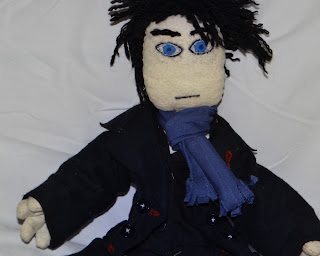 |
| Swatch Dolls- my design on Spoonflower printed Kona cotton. You can find the swatches for sale here. |
 |
| Sherlock Holmes- Designed by The Amazing Turnip Girl |
My dolls are less interesting, as shown above. They are basically cookie cutter dolls printed on Spoonflower swatches.
Stitching:
Generally, you'll use one of strand of thread and the smallest needle comfortable. You can used doubled threads but it makes a heavier seam and bigger holes in the fabric. My preference is a glazed cotton thread. It's smooth and easy to work with, try different threads and see what you like best. For hand sewing needles, my favorite are Clover Gold Eye sharps or quilting needles.
Originally, I used back stitching for all my dolls, and TG used a running stitch.
I've realized that while back stitch makes a sturdier seam, TG's dolls hold up just fine for her uses. Running stitch takes less time, but the problem is, it can be prone to gathering. So now I use a combination stitch. I start with a back stitch, and use a back stitch at every corner so my needle comes out at just the right place and the corners are reinforced. I also do a back stitch about every 5 stitches, which locks the thread so it doesn't gather.
It's very important for neat stitching and making sure everything lines up in small scale NOT to do a few stitches on the needle at a time. Put the needle in and pull the thread for each stitch. It makes neater stitches, and for small scale things, the little bit of extra time makes a neater finished product. For bigger things, there is more room for adjusting the slack.
Clipping Curves and Corners:
Clipping curves and corners helps a lot when you're turning the doll inside out. For outside curves, it allows the seam allowance to spread a bit instead of gathering and puckering. For inside curves, it reduces bulk in the curve. For corners, it works the same way. You clip the seam carefully after sewing. For outside curves, you just need to make snips in the fabric. For inner curves and corners, you should actually cut out a wedge. Examples of good cuts are shown below in red. You'd continue clipping the seam all the way around.
Stuffing:
There are lots of kinds of stuffing. The most environmentally minded is using scrap fabric of course. If you're going to do this, cut the fabric up very fine to keep it from bulging or lumping up in one area.
My daughter likes regular, old fashioned polyester fill stuffings. You know the kind that look like a big cotton ball that you pull off bits of to stuff? She likes it because it stuffs more firmly, and it's neat and tidy to use it so she doesn't wind up with lots of stuffing bits on her bed where she sews. It's easy to wash and dry.
I prefer cluster stuffing. It's also made of polyester, but it acts sort of like down filling. The individual clusters shift around and have lots of room for air making very soft stuffed toys. It's easy to wash and dry, but like washing down filled coats and comforters, a tennis ball in the dryer helps distribute the fluff. TG doesn't like cluster fill because "It's messier."
Cotton batting has the advantage of being easily cold water washable and you can scent it easily with fragrance oils. It's a good choice for something like sachet type dolls that can be scented and put in a lingerie drawer or scented pin dolls.
Little plastic pellets are available for a bean bag type filling. A lot of people also use them in amigurumi to weight the bottom. I use polyester fill and high density plastic pellets for air guns in my amigurumi.
Wool batting needs to be laundered a bit more carefully, but it's a really superior stuffing for heirloom toys.
For the dolls above, since I don't plan to wash them, just wipe them occasionally with a wet cloth if necessary, I sewed tiny sachets filled with lavender and put it in with the stuffing.
I use a long pairs of tweezers to fill nooks and crannies. A knitting needle will also help get stuffing into small areas.
You can buy the swatches for the dolls at the top from my swatch toy page on Spoonflower. Swatches are 5.00 each, but occasionally they go on sale, and once a year, Spoonflower has a free swatch day.







Love it! Used it as a prop for Halloween.
ReplyDeleteThanks for the tips! I've been doing back stitches too, so I'm going to try it your way now :)
ReplyDeletehello, thanks so much for this article, i want to make dolls like your daughter does, i only like hand stitching and i can't find any books on amazon that are meant for hand stitching.... do you know of somebody who has written one? or could you write one? :)
ReplyDelete